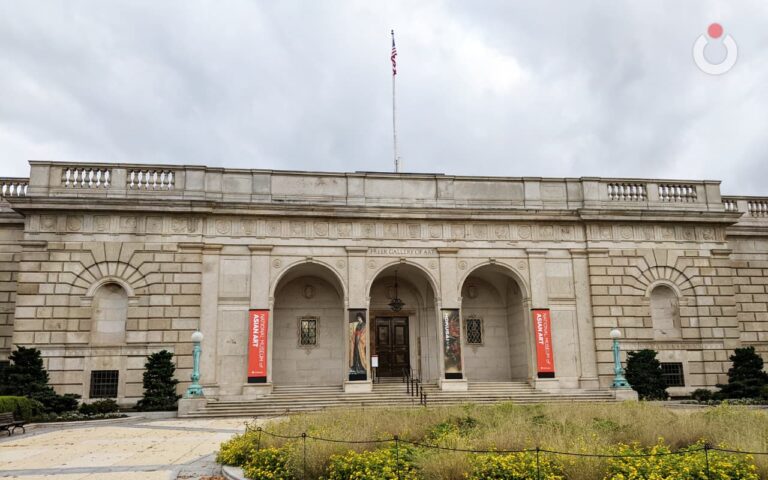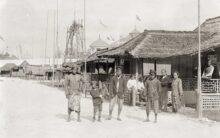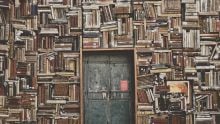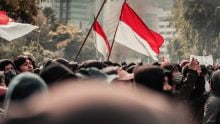Anne Rasmussen, Mbah Nun, KiaiKanjeng, and Plans for Performance at the Smithsonian Institution, Washington DC: Delayed due to Covid

The sky was gloomy that afternoon in mid-February 2020. Snowflakes were slowly falling. My hand felt cold when it touched the window which separated me from a wind chill temperature of minus 10 degrees Celsius. I was solemnly looking at the vastness of Midway Plaisance Park covered in a white expanse of snow from behind the wide windows of the D’Angelo Library at the University of Chicago Law School.
The cellphone screen on the table in front of me suddenly changed. There was an incoming call. I don’t recognize the number. From the area code, though, I recognized the state of Virginia. Luckily my cellphone was set to silent mode, because in this room of the library room “silence is golden.”
I hesitated to answer the call, worried it might just be an insurance agent. But somehow it didn’t feel like it would be an agent, because numbers that involve promotion and persuasion are usually automatically filtered with a spam warning. I had to go out to the lobby to answer the call.
“Hello, good afternoon…”
“Hello Pak Jamal, I’m Ibu Anne…”
Oh, so it turns out that it is Ibu Anne Rasmussen. I haven’t had time to save her number since our initial contact via email. That was the first direct communication with her since I arrived in America. We had met in person in Indonesia several times when I accompanied Mbah Nun. Either in Kadipiro or while touring with KiaiKanjeng in Malang and Semarang.

We talked for quite a long time. I told her about why I was in South Chicago and about my wife’s future dissertation research plans on Maiyah, the community of Emha Ainun Nadjib (also Cak or Mbah Nun) and the ensemble KiaiKanjeng. It turns out that Ibu Anne spent her childhood around the University of Chicago. If I remember correctly, her father studied at the U of Chicago for his Ph.D. And Ibu Anne went to Northwestern University, one of the bona fide campuses in America which is located in Evanston, Illinois, just north of Chicago.
However, the essence of our communication was actually about Mbah Nun and KiaiKanjeng’s plans to perform in America in June 2020. Initially, Cak Zakki, KiaiKanjeng’s manager, informed me that CNKK (Cak Nun-KiaiKanjeng), through Ibu Anne, had been invited to America. I was asked to communicate with Ibu Anne as the US representative of CNKK and to help with the preparations for their visit. Following our conversation, communication was then established intensively via email between me, Ibu Anne, Michael Wilpers, and the Indonesian Embassy.
Michael Wilpers, who was involved with cultural programming at the Smithsonian Institution, sent an official invitation to me indicating that Mbah Nun and Kiai Kanjeng were invited by the National Museum of Asian Art in collaboration with Dr. Anne Rasmussen. This museum is part of The Smithsonian in Washington DC., which houses 21 museums and America’s national zoo, is the largest museum complex in the world. Furthermore, all of the museums in Washington D.C. are free and open to the public, which is an amazing resource!
The performance date was determined. Saturday, June 20, 2020, which coincided with the Smithsonian’s annual Summer Solstice Saturday celebration. Every year, in celebration of the longest day of the year, the museum stays open all day until midnight. (Usually, they close at 6 p.m.)
CNKK was not the first Indonesian group to be invited by the Smithsonian. CNKK was chosen as the finale in the fourth “Performing Indonesia” series. This series started previously in October 2019 by presenting Endah Laras and Danis Sugiyanto’s keroncong. It was to be followed by Haji Rhoma Irama on May 30, 2020. The climax was to be the closing by Mbah Nun and KiaiKanjeng, the headliners in this series.

The rundown for the event went something like this: KiaiKanjeng was set to appear at 7 pm, as an outdoor performance in the courtyard of The Freer Gallery of Art. The performance was to be presented directly to the American public on the vast National Mall – a 59 hectare “square” in the heart of Washington DC. This mall, which is actually part of the American National Parks system, is located in front of the US Capitol Building and stretches all the way to the Washington Monument – America’s National Monument; it also connects to the backyard of the White House.
The backup scenario for the performance was that if it rains on the day, KiaiKanjeng would move to the indoor stage to the Meyer Auditorium in the same museum complex. And after the main performance, KiaiKanjeng was asked to perform briefly as a “pop-up” in the gallery for a closer and warmer interaction with the public. The next day, on Sunday afternoon, Mbah Nun was to give a lecture on how he, together with KiaiKanjeng, he has been a catalyst for social justice and community empowerment through the group’s various performances and workshops over more than two decades.
An official letter was sent, the theme of the event was clear, the schedule was determined, the location was confirmed along with a “plan B.” Even though it was generous, the funding provided by The Smithsonian, was, after calculating, still less than half of the total requirements. Nevertheless, planning was underway! Michael Wilpers asked me to send photos of KiaiKanjeng for promotional materials, with technical details to be discussed later on. Next it was KiaiKanjeng’s turn to prepare itself.
With the event less than six months away. Cak Zakki determined that approximately 22 people would go, including Mbah Nun, Mrs. Novia, and several crew members as well as Progress. KiaiKanjeng members who were unable to participate already had replacements in line. First and foremost, everyone had to have a passport.
Of course KiaiKanjeng members all had passports because this was not the group’s first time abroad. The problem was whether individual passports were still active. It was immediately conveyed in the KiaiKanjeng WA group to renew the passports of those members whose documents had expired. To travel to the US a passport must be valid for at least six months. As it turned out, almost everyone’s passports had expired and were no longer valid. Ha ha! That was a wake-up call!!

The next challenge was applying for a visa. Without a visa, we would not be able to enter the the U.S. And an American visa is the top number one visa which is the most restrictive and difficult to obtain. Not to mention the very expensive processing costs. If you follow the current dollar exchange rate, each person was expected to pay 2.7 million rupiah (about $175 dollars). And even if the visa application was rejected, the money would be forfeited, a forced contribution to the US government and embassy in Indonesia!!
For this reason, I researched the types of visas available and the probability of their suitability to KiaiKanjeng. There is one type of visa that is suitable, namely the P-3 visa for artists invited to perform in America. But for the application, The Smithsonian would have had to go through extra bureaucratic channels with the immigration and homeland security departments. It seemed to be a lot of trouble.
From the results of the discussion, the most likely visa seemed to be the one suggested by the Indonesian Embassy: a B visa for tourists. Later a letter of recommendation would be made from the Indonesian Embassy in Washington DC and The Smithsonian, with the hope that the US Embassy would grant all visas in time for the trip.
I immediately imagined how much trouble it was for the KiaiKanjeng members to arrange this visa. Each of them had to fill out a fairly detailed online form of 10 pages. Then these 22 people had to come to the American embassy in Jakarta to be interviewed one by one. Except for Mbah Nun and Mrs. Novia who already had a 5-year tourist visas since September 2015, when they were invited to the Al-Falah Mosque in Philadelphia.

Meanwhile, after initial confirmation in early February of CNKK’s visit to America, I tried to communicate the possibility of CNKK to other cities. The first thing that came to mind was of course the Indonesian immigrant community in Philadelphia. Even though the Al-Falah Mosque administrators had not yet agreed, at least Mas Adit – the mosque resident who initiated Mbah Nun’s arrival in Philadelphia in the past – and his Gapura foundation were ready to facilitate a visit by the whole group.
At that time I also tried to explore the possibility of CNKK performing on campuses, especially those with gamelan ensembles and ethnomusicology programs. Several of these campuses are located in the East Coast region where they can be reached in a matter of hours by car. Apart from Philadelphia and Washington DC of course, there was the possibility of New York City and Middletown in Connecticut, both cities only a few hours by car from the nation’s capital city. In Middletown, Connecticut, Wesleyan University’s gamelan studies program is world famous, with Professor Sumarsam from Solo, an esteemed member of Wesleyan’s faculty.
***
That is an overview of the CNKK visit to USA 2020. Since the invitation came in mid-February, discussions continued apace and initial preparations for KiaiKanjeng were all carried out diligently. But God apparently had other plans. In March the world changed as the Corona virus began to spread throughout leaving no region untouched. By the end of March, countries closed their doors to entry. Everyone was in lockdown, including America.
Ibu Anne contacted me to express how drastically the situation had changed since our initial communication. And at the end of March, Mr. Wilpers sent an email saying that the Smithsonian was officially stopping all activities from then on, including plans for events in June.
We all didn’t know how long the pandemic situation would last. And all of us around the world hoped that Covid-19 would pass in a few months, including The Smithsonian, which offered to postpone the visit until the coming in the fall in October 2020. I forwarded this news to Cak Zakki and CNKK. At that point in time, everyone thought the pandemic would end in the fall season. Who would have thought that the Coronavirus would have lasted for more than two years?!?
In October 2020, I was able to go to Washington DC, thank God. But unfortunately, not with CNKK. Not long after I got my Illinois driver’s license, I accompanied my friend from Riau who also lived in Chicago. The only way we could travel safely during the pandemic was by car. We took turns driving the 12 hours from Chicago to Washington DC. He had to go there to meet someone, let’s call him Pak Gemoy. My friend, a year earlier, was one of the spokespeople when Pak Gemoy ran for president. And while visiting Washington DC, Pak Gemoy happened to have a birthday. So, my friend, wanted to stay in touch and honor him directly by traveling to Washington DC, while he was there.
I did not join my friend at the thanksgiving banquet that was facilitated by the Indonesian Embassy, because I, myself, have nothing to do with Mr Gemoy. That afternoon I chose to walk around the front yard of the White House which was not far from our hotel. There I could still see the remains of the Black Lives Matter demonstrations and riots of the previous July.

I walked around the white house and on to the National Mall. I combed the edge of this 59 hectare “square”. I turned right first to the statue of Abraham Lincoln and the Lincoln Memorial at the west end of the mall. This is also the place of Martin Luther King’s famous speech “I Have a Dream.” Then I turned around and continued past the edge of the large pool to the middle of the field around the Washington Monument and World War II Memorial. I continued walking east to the end of the Mall where at the Congress building, the US Capitol is situated.
From the terrace of the US Capital I looked far into the center of the Mall. On either side of the field from where I was standing all the way to the Washington Monument, there were rows of Smithsonian museums. If you are serious and intentional, it will take 1 month to visit everything completely from the Air and Space Museum, to the National History Museum, to several art museums, to the first “born digital” museum, the National Museum of African American History and Culture.
My gaze was fixed on a point on the left side of the field. And I started walking. It took 20 minutes to get there. When I got to the Smithsonian Museum of Asian Art, also the Freer Sackler Gallery, I immediately sat on the terrace and looked out over the field looking at the Washington Monument in the distance. It is on this terrace that in June 2020, or if the pandemic could have been controlled, in October 2020, just when the temperature is starting to get cold and the leaves are turning bright colors, that Mbah Nun and KiaiKanjeng should be performing.
I sat in silence for a long time imagining the happy atmosphere for Americans that KiaiKanjeng could have built through its musical creativity. Like the joy felt by people in remote Indonesian villages when they gather together in learning circles with Mbah Nun and KiaiKanjeng.

I took several photos of the Freer Gallery location at the National Museum of Asian Art. Then I remembered Ibu Anne. The place where she teaches, the College of William & Mary is not too far from here – about a 3-hour drive to Williamsburg, Virginia. But when I was in the US, her campus was still closed. The students had all been sent home to study online only. And from Instagram I saw that Ibu Anne was working from home with her family from the beautiful Colorado mountains.
***
I thought of writing these Pandemic Memories into a short article when last weekend Cak Zakki reported on the KiaiKanjeng WA group that Ibu Anne was in Yogyakarta. Last Wednesday she attended Tawashshulan in Kadipiro. Even though I had just been with KiaiKanjeng members for performances at Kenduri Cinta-Indramayu-Pemalang, at that time, November 1, I had just left Yogyakarta so I missed seeing Ibu Anne at the KiaiKanjeng headquarters in Rumah Maiyah, Kadipiro.
In fact, since our communication in early 2020, I have not seen her again. In 2022, when Ibu Anne was with CNKK in Malang, I was still in Chicago. In 2017, however, I had a chance to chat and interview her for a while at Kadipiro. From that conversation, all I remember is that she was still shocked at how Donald Trump could be the president of her country.

I was really impressed by Ibu Anne’s friendship and kinship towards Mbah Nun and KiaiKanjeng: sincere brotherhood for so long: 23 years since she first met Cak Nun. Ibu Anne is one of the few scholars and artists who have recorded and witnessed CNKK’s work in helping to dialogue with society in horizontal conflicts in Indonesia following the period of reform (Reformasi). She has authored a number of scholarly publications which can be found in various places, including in the book Music and Conflict, published in 2010. Her article is entitled “Performing Religious Politics: Islamic Musical Arts in Indonesia.”
In the same year, Ibu Anne also released her book Women, the Recited Qur’an, and Islamic Music in Indonesia which was translated into Indonesian and published by Mizan Press in 2019 with the title Merayakan Islam dengan Irama: Perempuan, Seni Tilawah dan Musik Islam di Indonesia. The book was endorsed with a statement on the cover by Mbah Nun. As a professor of ethnomusicology, she captures CNKK in its service to society through the form that we now know as Sinau Bareng (Learning Together) as a unique phenomenon.
In one of her other articles, “The Arab Musical Aesthetic Islam in Indonesia,” published in a special issue of the journal The World of Music: Musical Reverberation from the Encounter of Local and Global Belief Systems (2005), Ibu Anne notes the position of KiaiKanjeng as a variable of gamelan da’wah. Especially during the chaos of the Reformasi. Anne Rasmussen sees Mbah Nun and KiaiKanjeng as carrying out social justice movements through music, conversation, drama, and prayers. At that time, she witnessed Mbah Nun and “mini” KiaiKanjengs sprouting up in village after village and in Jakarta which was in still in chaos due to the riots, in order to heal the hearts of the little people and the grass roots through conversation, music, and prayers together.
Ibu Anne also highlights her interaction with Mbah Nun and KiaiKanjeng at a show in Semarang in 2017 and you can see a video klip of a funny moment during that performance in her “Tack Faculty Lecture, titled Women Out Loud!” Check it out at about 26:00 minutes into her talk HERE.

However, more than all these notes on her scholarship, for me what is important is the sincerity of her research, fieldwork, and humanity. Ibu Anne’s travel is about 36 hours door to door and when in the country she never misses a chance to intersect with Mbah Nun and KiaiKanjeng.
As stated by Ibu Anne at the end of Tawashsulan in Kadipiro last Wednesday, every event Mbah Nun and KiaiKanjeng holds is always extraordinarily creative and inclusive, involving all kinds of people along with a variety of ritual and musical joy. Ibu Anne feels that there is definitely a place for her with KiaiKanjeng. That’s why she keeps coming back. Ibu Anne also testified that Rumah Maiyah Kadipiro was one of the most culturally rich places in her experience of Indonesia.
Who knows, in the future whether God will still want to take Mbah Nun and KiaiKanjeng to America through Ibu Anne and her connections. Because of the five continents on this earth, North America is the only continent that CNKK has not yet visited.
If one day CNKK really go to America and I’m still there, maybe I’ll just take Mbah Nun and KiaiKanjeng to two places. Pilgrimage to Muhammad Ali’s grave and to the gemstone paradise in Atlanta. [Haha]. And perhaps, after our performances in Washington DC, we can accept Ibu Anne’s invitation to visit her home in Williamsburg, Virginia and her campus, the College of William & Mary.
Pinggirsari, 3 November 2023
The original article is in Indonesian entitled “Anne Rasmussen, Mbah Nun, KiaiKanjeng, dan The Smithsonian Washington DC yang Tertunda.” This English version is translated by Anne Rasmussen.










